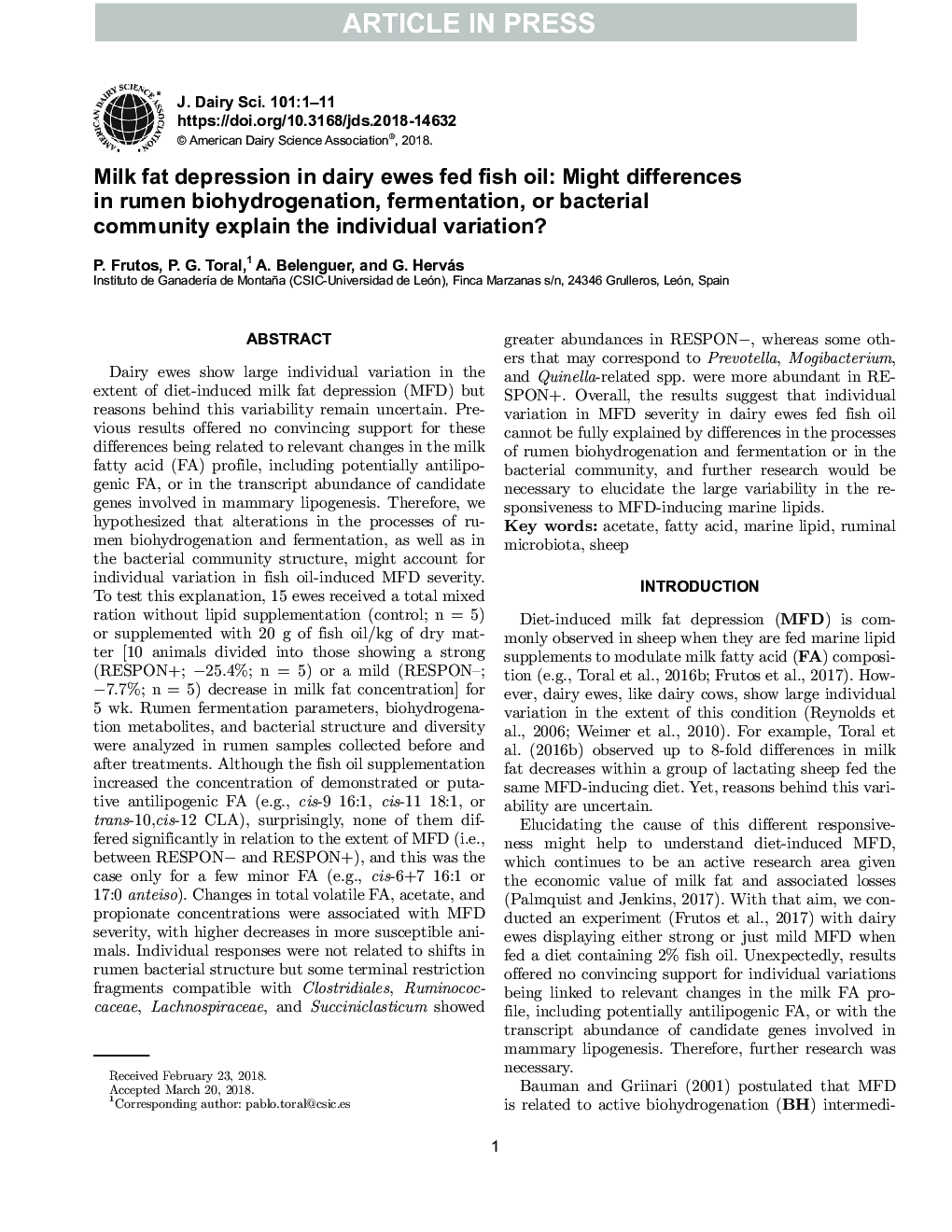| کد مقاله | کد نشریه | سال انتشار | مقاله انگلیسی | نسخه تمام متن |
|---|---|---|---|---|
| 8501004 | 1553838 | 2018 | 11 صفحه PDF | دانلود رایگان |
عنوان انگلیسی مقاله ISI
Milk fat depression in dairy ewes fed fish oil: Might differences in rumen biohydrogenation, fermentation, or bacterial community explain the individual variation?
ترجمه فارسی عنوان
افسردگی چربی شیر در جوجه های شیری روغن ماهی را تغذیه می کند: تفاوت های موجود در بیو هیدروژن زدایی شکمبه، تخمیر، یا جامعه باکتریایی تغییرات فردی را توضیح می دهد؟
دانلود مقاله + سفارش ترجمه
دانلود مقاله ISI انگلیسی
رایگان برای ایرانیان
کلمات کلیدی
استات، اسید چرب، لیپید دریایی، میکروبیولوژیک شبیه گوسفند،
موضوعات مرتبط
علوم زیستی و بیوفناوری
علوم کشاورزی و بیولوژیک
علوم دامی و جانورشناسی
چکیده انگلیسی
Dairy ewes show large individual variation in the extent of diet-induced milk fat depression (MFD) but reasons behind this variability remain uncertain. Previous results offered no convincing support for these differences being related to relevant changes in the milk fatty acid (FA) profile, including potentially antilipogenic FA, or in the transcript abundance of candidate genes involved in mammary lipogenesis. Therefore, we hypothesized that alterations in the processes of rumen biohydrogenation and fermentation, as well as in the bacterial community structure, might account for individual variation in fish oil-induced MFD severity. To test this explanation, 15 ewes received a total mixed ration without lipid supplementation (control; n = 5) or supplemented with 20 g of fish oil/kg of dry matter [10 animals divided into those showing a strong (RESPON+; â25.4%; n = 5) or a mild (RESPON-; â7.7%; n = 5) decrease in milk fat concentration] for 5 wk. Rumen fermentation parameters, biohydrogenation metabolites, and bacterial structure and diversity were analyzed in rumen samples collected before and after treatments. Although the fish oil supplementation increased the concentration of demonstrated or putative antilipogenic FA (e.g., cis-9 16:1, cis-11 18:1, or trans-10,cis-12 CLA), surprisingly, none of them differed significantly in relation to the extent of MFD (i.e., between RESPONâ and RESPON+), and this was the case only for a few minor FA (e.g., cis-6+7 16:1 or 17:0 anteiso). Changes in total volatile FA, acetate, and propionate concentrations were associated with MFD severity, with higher decreases in more susceptible animals. Individual responses were not related to shifts in rumen bacterial structure but some terminal restriction fragments compatible with Clostridiales, Ruminococcaceae, Lachnospiraceae, and Succiniclasticum showed greater abundances in RESPONâ, whereas some others that may correspond to Prevotella, Mogibacterium, and Quinella-related spp. were more abundant in RESPON+. Overall, the results suggest that individual variation in MFD severity in dairy ewes fed fish oil cannot be fully explained by differences in the processes of rumen biohydrogenation and fermentation or in the bacterial community, and further research would be necessary to elucidate the large variability in the responsiveness to MFD-inducing marine lipids.
ناشر
Database: Elsevier - ScienceDirect (ساینس دایرکت)
Journal: Journal of Dairy Science - Volume 101, Issue 7, July 2018, Pages 6122-6132
Journal: Journal of Dairy Science - Volume 101, Issue 7, July 2018, Pages 6122-6132
نویسندگان
P. Frutos, P.G. Toral, A. Belenguer, G. Hervás,
